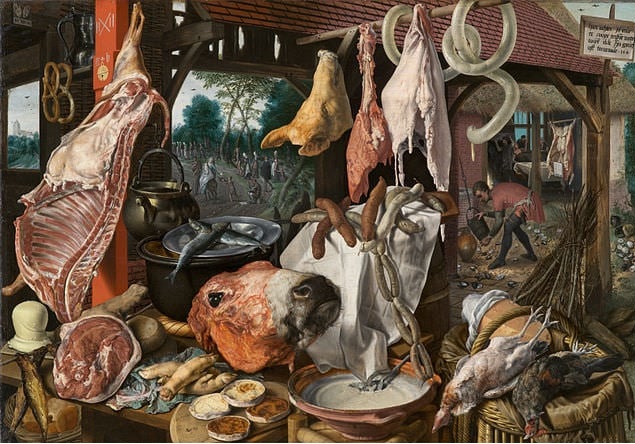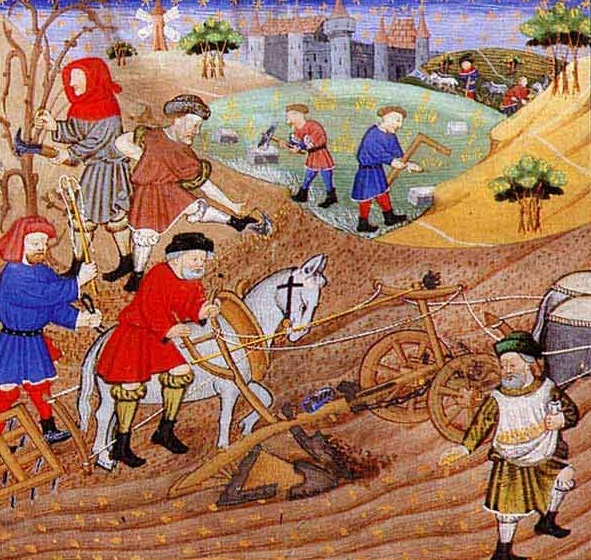Medieval merchants, who traveled and traded goods, had to be prepared to find food and sustenance while on the road, as they faced the challenges of obtaining adequate nutrition while away from home.
In this article, we will explore the types of food that medieval merchants ate, how they obtained it, and the role of food in their work.
Types of Food
Medieval merchants ate a varied diet that included both everyday and luxury items. Some of the foods that were commonly consumed by merchants included:
- Grains: wheat, oats, and barley, were a staple of the medieval diet and were often ground into flour to make bread, porridge, and other dishes. Merchants might carry grains with them on their travels, or they might purchase bread and other grain-based foods in the towns and cities they visited.
- Meat: chicken, pork, and beef was also a significant part of the medieval merchant’s diet. Merchants might hunt or raise their own animals, or they might purchase meat from local markets or farms.

- Fish: this was another important source of protein for medieval merchants, and it was often preserved by salting or drying. Merchants might catch their own fish, or they might purchase it from local markets or fishing villages.
- Vegetables: beans, peas, and onions, were also a part of the medieval merchant’s diet. These were often grown locally and could be purchased in markets or at roadside stands.
- Fruits: apples, pears, and berries were also consumed by medieval merchants. These were often seasonal and could be difficult to obtain during certain times of the year.
- Spices: pepper, cinnamon, and ginger were used to flavor and preserve food in the medieval period. Merchants were often involved in the trade of spices, and they might use these in their own cooking as well.
- Luxury foods: In addition to these everyday items, medieval merchants occasionally enjoyed luxury foods, such as exotic fruits, fine cheeses, and expensive meats, if they could afford them. These were often imported from other parts of the world and were only available to the wealthy.
Obtaining Food
Medieval merchants had several options for obtaining food on their travels. Some of the ways they acquired food included:
- Purchasing food: Merchants could purchase food in the towns and cities they visited, either from markets or from local farmers and producers. They might also trade their goods for food with other merchants or local residents.
- Hunting and gathering: In some cases, merchants actually hunted or gather their own food while on the road. This could include hunting game, fishing, or foraging for berries and other wild plants.
- Growing their own food: While not that widespread, some merchants also grew their own food, either by cultivating crops or by keeping animals for meat and other products.

The Role of Food in Medieval Trade
Food played a crucial role in the work of medieval merchants in several ways:
- As a commodity: Food was often a valuable commodity in itself, and merchants might trade in food products such as grains, spices, and luxury foods.
- As a source of sustenance: Food was also essential for the survival and well-being of medieval merchants, who had to be able to sustain themselves on the road. They had to be able to find or acquire food in order to keep themselves nourished and healthy.
- As a means of exchange: merchants sometimes traded their goods for food or used food as a way to pay for other services, such as lodging or transportation.
- As a way to connect with others: Food could also serve as a way for merchants to connect with others on their travels, whether by sharing meals with other merchants or by sampling local cuisines.
Food and Social Status
Food could also be a marker of social status in the medieval period, with wealthier merchants able to afford more expensive and luxurious foods.

These luxury foods, such as exotic fruits, fine cheeses, and expensive meats, were often imported from other parts of the world and were only available to the wealthy.
Conclusion
Medieval merchants ate a varied diet that included grains, meat, fish, vegetables, fruits, and spices. They obtained food through a variety of means, including purchasing it, hunting and gathering, and growing their own.
Food played a significant role in the work of medieval merchants, serving as a commodity, a source of sustenance, and a means of exchange. It also played a role in social status, with wealthier merchants able to afford more luxurious foods.
Overall, food was an important part of the lives of medieval merchants, who had to be able to sustain themselves on the road and make connections with others through the sharing of meals.
